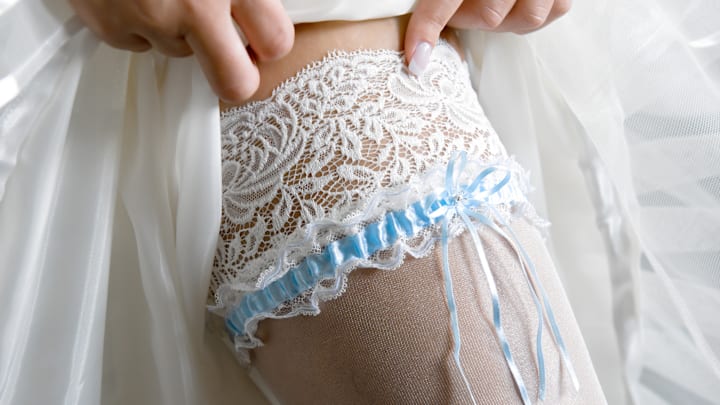The garter toss is an iconic part of most modern weddings, like cutting a wedding cake or having a father-daughter dance. For those who participate, it serves a similar function as the bride’s bouquet toss, jokingly designating who—of the groom’s single male friends—will be married next.
It’s a decidedly less innocent practice, however. It generally involves the groom hiking up or ducking under the bride’s wedding dress to remove the garter from her thigh—often with his teeth—before throwing it to the crowd.
Where, though, did this risqué ritual come from, and how did it come to be so ingrained in our wedding celebrations? Below, we break down the somewhat dark—and definitely uncomfortable— history surrounding the garter toss in the first place.
- The Possible Origins of the Garter Toss Tradition
- The Modern-Day Evolution of the Garter Toss Tradition
The Possible Origins of the Garter Toss Tradition
The most common story behind the garter toss is that it comes from all the way back in the Middle Ages. As medieval marriages were expected to be consummated immediately after the wedding celebration, crowds of guests may have waited outside (or even watched) as the deed was done. Therefore, giving the bride’s garter to those in attendance may have been a way to “confirm” the consummation.
Alternatively, tossing a bride’s garter might have been a way to protect both the bride and her ensemble in the same era. Because pieces of a bride’s outfit were considered good luck, it’s said that people would clamber to rip off whatever pieces of it they could after the wedding. Throwing one of the bride’s garters at this rowdy crowd was supposed to have been a way to give them something controlled to clamor after.
The Modern-Day Evolution of the Garter Toss Tradition
In fact, the garter toss may not actually be as much of a time-honored tradition as previously believed.
“I haven’t found any evidence of a staged garter toss happening at a wedding before the mid-1950s,” Kimberly Chrisman-Campbell, a fashion historian, told Vogue. “Many wedding ‘traditions’ are pretty recent, while a lot of the things we think of as being very modern—like the getaway dress or the bachelorette party—are actually centuries old.”
Chrisman-Campbell suspects that instead of being passed down from the Middle Ages, the garter toss likely only came about after World War II. During the war, the United Service Organizations hosted entertainment shows for homesick soldiers. These were often raunchy burlesque shows in which entertainers sometimes cheekily flung their garters into the delighted crowds of young men.
Notable garter-tossers like silent film star Marlene Dietrich and singer Martha Tilton helped propel the image into the public eye and make it stick as a metaphor for “deflowering” a woman. As marriage is also traditionally associated with this concept, the practices merged, and the garter toss started taking place at weddings. By the 1960s, magazines were officially calling the garter toss a “tradition.”
Today, the garter toss isn’t nearly as ubiquitous as it used to be. Though many brides still wear decorative garters under their dresses, in 2018, only an estimated 37 percent of couples getting married incorporated a garter toss into their wedding. They cited reasons like its awkwardness and how old-fashioned it can feel. Same-sex couples are particularly unlikely to participate in this wedding tradition, though they’re also less likely to prioritize traditional wedding practices altogether.
As with all parts of a wedding, whether the garter toss makes an appearance is completely up to the couple’s preferences. But only time will tell if the tradition keeps losing steam over time or if it’ll see a resurgence in future years.
Read More About Weddings:
